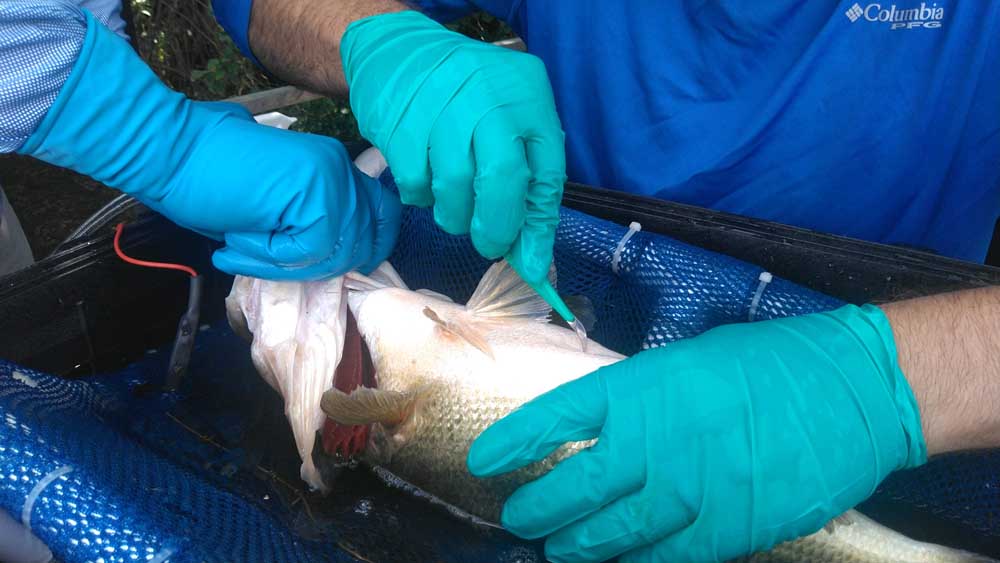Here and There: TPWD study shows bass have not disappeared
Published 9:00 am Friday, July 12, 2024

- A TPWD study was conducted by catching bass and fitting them with transmitters before releasing them back into the Lake Fork and Toledo Bend. (TPWD)
Myth Busters, The Fishing Version might be a good name for a two-year Texas Parks and Wildlife Department Inland Fisheries study looking at largemouth bass.
The study was the result of fishermen’s concern over a drop in catch rates that many blamed on decreased fish populations. Lake surveys showed fish numbers remained consistent, so the next question was does increased pressure impact bass habits.
“Part of basis for the study was, have fish evolved to stay away from popular target habitat,” explained Jake Norman, who along with Todd Driscoll were the principal researchers for the study conducted on lakes Fork and Toledo Bend.
Ok, here is a spoiler alert: Despite the heavy pressure on Texas’ lakes, bass still prefer to hang out around vegetation, timber, drop-offs, points and flats.
The study was conducted by catching bass and fitting them with transmitters before releasing them back into the two lakes. Over the two years, 38 were tagged on Fork and 43 were tagged on Toledo Bend. Interestingly, only a couple were reported caught by fishermen.
Periodically the biologists would return to the lakes, tract down the fish and watch their reactions and movement to things like boat noise, baits and weather changes. They used forward-facing sonar and telemetry data to get possibly the best view of bass activity in their natural habitat to date.
“By and large these fish were home bodies. Their home range or core use areas where they occupied the bulk of their time was between 10 and 11 acres per fish,” Norman explained. He added the home ranges were slightly larger on Toledo Bend, which makes sense considering the size difference between the two lakes.
Like humans, each fish had its own personality and while many stayed close to where they were released, a few would make a long run before eventually returning. The most notable of those was a bass on Toledo Bend that traveled 11 miles outside its core area, stayed a few weeks and then returned. Fork had two fish that left the home ranging and never returned.
For the remainder of the bass, it was basically run up and down the shoreline, and occasionally into deep water.
“To an extent we didn’t find fish that stayed deep consistently. They stayed close to the structure they were caught on through June, and by July they left that and were pretty shallow,” Norman said. And by shallow he is referring to 10 feet of water or less.
The study busted some of myths and misconceptions of bass fishing, starting with a bass’ reaction to noise.
“I hear people say that bass hear boat noise all the time and get accustomed to it. We completely proved that to be false,” Norman said.
The study showed 59% of all the fish reacted to boat noise somehow, with bass 20 inches and longer being more likely to react. Also, fish in vegetation reacted more often than those not in cover for some reason.
Another myth busted was the fall migration to the back of a creek to chase shad.
“That didn’t happen at all. We did see some changes seasonally, by no means did we see all the fish in the back of the creeks. The shad were there, and there was some bass migration, but our fish didn’t follow them at all,” Norman said.
Another belief dispelled was a migration to deeper-water structure after the spawn.
“Not all the fish move out and sit on structure. It just did not happen. When we put transmitters in fish, I thought, knowing Birch Creek fairly well, there were spots I believed we were going to find fish. It never did happen,” Norman said.
And while they might move some, the bass also did not make big moves into deep water around spring cold fronts.
What was not questioned was that good habitat attracts bass.
“Overall, fish are most frequently located on target rich habitat,” Norman said.
He added that fishermen fishing traditional holes with structure, vegetation, points or drop-offs have the right idea, but on lakes with a lot of pressure they are casting to educated bass. At the same time less-fished featureless flats can also hold fish, but they are just more spread out.
Results of the study have also provided TPWD biologists with data they may help them rethink management practices including sampling times on lakes.






